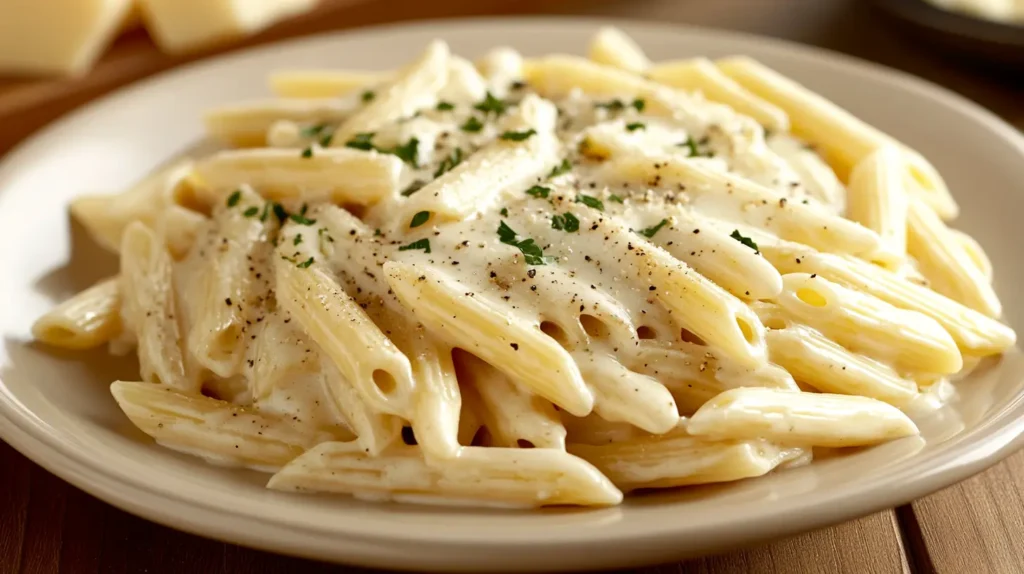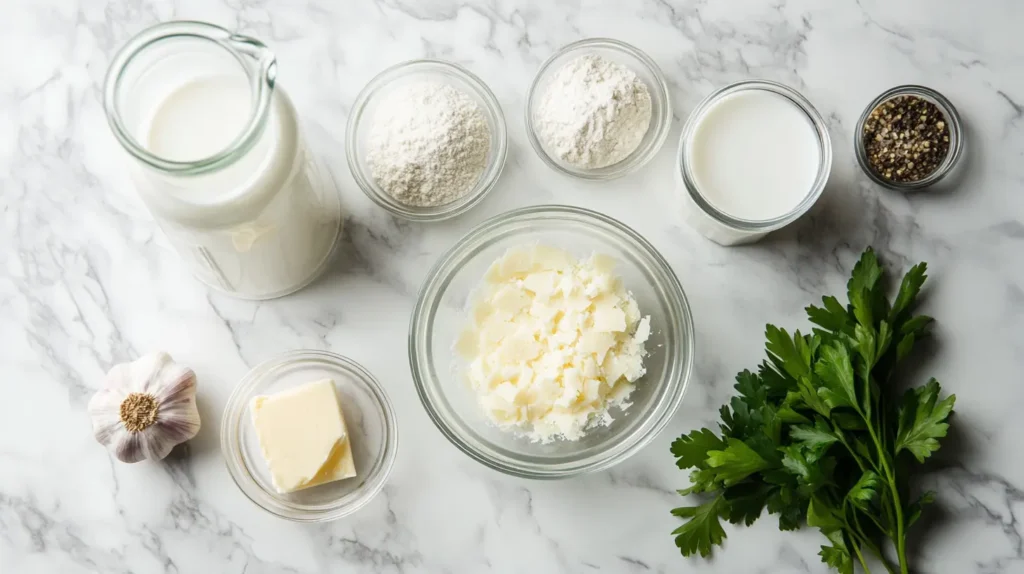Growing up in my grandmother’s kitchen, the smell of creamy Alfredo sauce was a sign of a special meal. That rich, velvety sauce over perfectly cooked pasta was more than a recipe. It was a cherished memory of comfort and connection.

Alfredo sauce is the epitome of rich pasta dishes. It takes simple ingredients and makes them a masterpiece. The traditional sauce pairs butter, heavy cream, and Parmesan cheese for a decadent topping.
If you’re a pasta lover or a home cook, learning to make Alfredo sauce can make any dish phenomenal. It’s simple and adaptable, so it’s a favorite among American kitchens everywhere.
Key Takeaways
- Alfredo sauce transforms ordinary pasta into a gourmet meal
- Simple ingredients create a vibrant and creamy sauce
- Versatile recipe works with multiple pasta types
- Homemade sauce tastes far superior to store-bought versions
- Perfect for busy weeknights or celebrating spacial moments.
Understanding Traditional Italian Alfredo Sauce
Alfredo sauce is a treasure in authentic Italian cuisine. It’s a creamy white sauce with a rich history. It shows the beauty of Roman cooking, turning simple ingredients into a luxurious pasta dish.
The story of Alfredo Sauce starts in Rome. Chefs there created a dish that became famous worldwide. It began in early 20th-century Italian kitchens, where simplicity and quality were key.
Origins of Alfredo Sauce in Roman Cuisine
Alfredo Di Lelio, a Rome restaurant owner, made this sauce famous. His recipe was simple yet perfect. It focused on a few key ingredients that showed true Italian culinary excellence.
- Created in Rome around 1908
- Originally made with parmesan cheese and butter
- Designed to enhance pasta’s natural flavors
Key Ingredients in Authentic Alfredo
Authentic Italian Alfredo sauce uses just a few top-notch ingredients. Parmesan cheese and creamy butter are the stars. They make a velvety sauce that sticks well to pasta.
Difference Between American and Italian Versions
American versions of Alfredo sauce are pretty different from the Italian ones. Traditional Italian sauce uses only butter and parmesan cheese. But American versions often add cream, making the sauce thicker and less true to its roots.
The authentic Italian way focuses on technique and quality ingredients. It shows the beauty of simple cooking in Italian cuisine.
Essential Ingredients for Perfect Alfredo Sauce
Making a delicious creamy sauce needs the right ingredients. These ingredients turn a simple pasta dish into a work of art. The key to a great Alfredo sauce is using top-notch dairy products for a smooth, rich texture.

- Heavy cream – provides luxurious richness
- Freshly grated Parmesan cheese – ensures authentic flavor
- Garlic – adds depth and aromatic complexity
- Unsalted butter – creates a smooth consistency
Garlic is essential for the sauce’s taste. Cooked gently brings out flavors that mix well with the creamy sauce. Some cooks say using fresh garlic cloves makes the sauce even better.
“The secret to an outstanding Alfredo sauce lies in the quality of ingredients and careful preparation.”
White wine is an optional but fancy addition to the sauce. A little dry white wine adds depth and makes the sauce more interesting.
| Ingredient | Quantity | Purpose |
|---|---|---|
| Heavy Cream | 1 cup | Creates creamy texture |
| Parmesan Cheese | 1 cup, grated | Provides authentic flavor |
| Garlic | 2-3 cloves | Enhances aromatic profile |
| White Wine | 1/4 cup | Adds complexity |
Trying herbs like parsley or basil can make your Alfredo sauce unique. This lets home cooks add their twist to this classic Italian dish.
Step-by-Step Guide to Making Alfredo Sauce
The perfect Alfredo sauce turns a simple pasta dish into a comfort food delight. This classic recipe needs precision and care. It aims to create a creamy, smooth texture that will wow the pickiest eaters.
Creating a delicious Alfredo sauce involves several key steps. These steps can boost your cooking skills. The trick is to understand the right mix of ingredients and techniques.
Workspace and Ingredient Preparation
- Gather all ingredients before starting
- Use fresh butter and heavy cream
- Grate Parmesan cheese finely
- Chop fresh parsley for garnish
Mastering Sauce Consistency
The secret to a velvety Alfredo sauce is in the temperature and whisking. Start by melting butter over medium-low heat. Then, add cream slowly while stirring constantly.
- Melt butter slowly in a heavy-bottomed pan
- Add heavy cream gradually
- Whisk consistently to prevent separation
- Incorporate Parmesan cheese off the heat
Troubleshooting Common Sauce Issues
To avoid grainy or separated sauce, pay close attention. Keep the heat low and remove the pan from direct heat when adding cheese. If the sauce gets too thick, thin it with some pasta water.
For a fresh touch, sprinkle chopped parsley on your Alfredo sauce. It adds color and a subtle herb flavor. This beautifully complements the rich, creamy sauce.
Pairing and Serving Suggestions with Alfredo Sauce
Creating a standout pasta dish with Alfredo sauce means choosing the right pairings. Classic fettuccine is a top choice, but you can also try penne or linguine for a twist—the sauce’s creamy texture pairs well with proteins and veggies.
Adding proteins can make your Alfredo a hearty meal. Grilled chicken adds a smoky touch, while shrimp brings sea flavor. For a salty kick, try crispy pancetta. Vegetarians can enjoy roasted broccoli or sun-dried tomatoes for extra flavor and nutrition.
How you present your dish matters a lot. Serve it right away to keep the sauce perfect. Top it with Parmesan cheese and parsley for a pop of color and taste. You can even use Alfredo sauce on pizzas or as a dipping sauce.
Remember, balance is everything when using Alfredo sauce. Mix ingredients wisely to keep the sauce’s creamy texture in mind. Each dish is a chance to make a lasting impression on your loved ones.
FAQ
What is the origin of Alfredo sauce?
Alfredo sauce comes from Rome, Italy. Alfredo Di Lelio made it in the early 1900s. The original recipe is just butter and Parmigiano-Reggiano cheese. The American version adds heavy cream, making it creamier.
What are the key ingredients in classic Alfredo sauce?
The actual recipe needs top-notch ingredients. You’ll need Parmesan cheese, butter, garlic, and sometimes white wine. Chefs say using Parmigiano-Reggiano gives the best taste.
How is American Alfredo sauce different from traditional Italian Alfredo?
American Alfredo is more prosperous, thanks to heavy cream and extra spices. The Italian version is lighter. It focuses on butter and cheese for a pure taste.
Can I make Alfredo sauce without heavy cream?
You can make it with butter, Parmesan cheese, and pasta water. This way, you get a lighter, truer Alfredo sauce that doesn’t need cream.
What pasta works best with Alfredo sauce?
Fettuccine is the top pick, but linguine, penne, and rigatoni work well too. Choose pasta that lets the sauce cling to it.
How can I prevent my Alfredo sauce from becoming grainy?
Use low heat and add the cheese slowly while whisking. Keep ingredients at room temperature and grate cheese fresh. This way, your sauce stays smooth and creamy.
What proteins pair well with Alfredo sauce?
With Alfredo sauce, grilled chicken, shrimp, pancetta, and salmon are plentiful. They add flavor and nutrition to the dish.
How long can I store homemade Alfredo sauce?
In a sealed container, you can keep it in the fridge for 3-4 days. Add a bit of milk or pasta water to reheat to keep it creamy.
